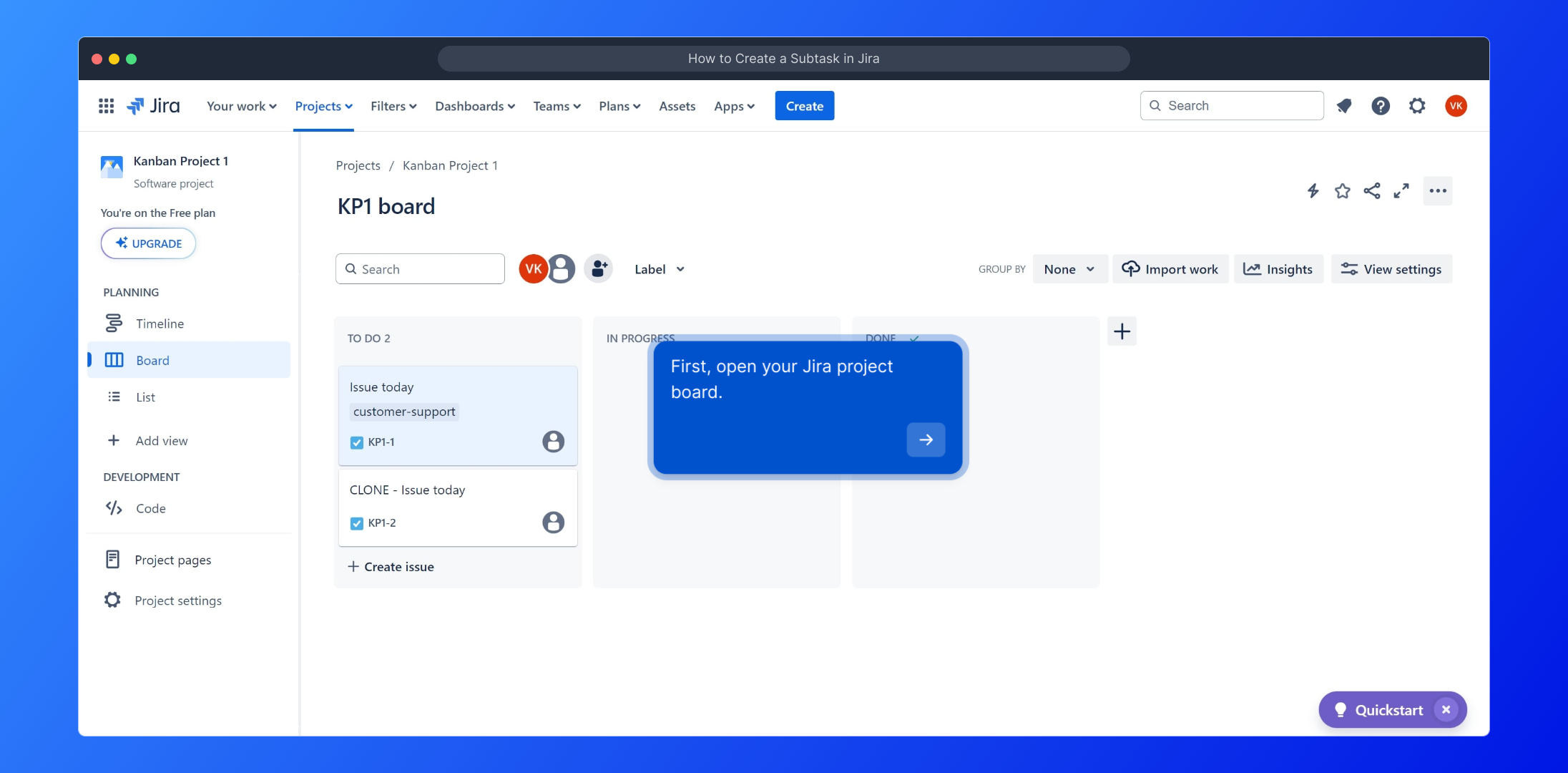1. First, open your Jira project board.
2. Navigate to and click on the issue for which you want to create a subtask.
3. Then click on "Add a child issue".
4. Video Step
(Play Now)5. Next up, click on "Create".
6. You have done it! The subtask has been created on Jira.
7. Create a Supademo in seconds
This interactive demo/guided walkthrough on How to Create a Subtask in Jira was created using Supademo.
How to Create a Subtask in Jira : Step-by-Step Guide
Start by opening your Jira project board where all your current tasks and issues are organized. This will serve as the workspace to manage and track your projects efficiently.

From your project board, locate the specific issue you want to break down further. Click on that issue to open its detailed view, which allows you to add more information including subtasks.

Inside the issue details, look for the option labeled "Add a child issue." Selecting this will begin the process of creating a subtask, helping you organize smaller, manageable units within the main task.

This step includes a helpful video tutorial to visually guide you through the process of adding a child issue.
(Watch the video for detailed instructions)

After filling out the necessary details for your subtask, click the "Create" button to save it. This will add the subtask under the main issue, making it easier to track progress.

Congratulations! Your subtask has now been successfully created and linked to the parent issue within Jira, allowing for better task breakdown and project management.

Discover how easily you can create a Supademo in just a few moments, unlocking powerful ways to showcase and manage your workflows.

Create your own interactive demos in < 5 mins with Supademo
You can create your own interactive product demo in minutes using Supademo. Drive growth, scale enablement, and supercharge product-led onboarding with Supademo.
Sign up for free here with no credit card required.
FAQs
What is a subtask in Jira?
A subtask in Jira is a smaller, more manageable task that is linked to a parent issue. It helps break down complex work into simpler components, allowing teams to organize and track progress more effectively within a project.
How do I create a subtask in Jira?
Open your Jira project board, select the issue to which you want to add a subtask, click on "Add a child issue," fill in the details, and click "Create." The subtask will then be linked under the parent issue for better task management.
Can subtasks have their own assignees in Jira?
Yes, subtasks can have their own assignees, allowing team members to take responsibility for specific parts of the larger parent task. This feature helps distribute workload effectively within a project.
Are subtasks counted in the parent issue’s progress?
Yes, progress on subtasks typically contributes to the overall progress of the parent issue. Completing subtasks helps track incremental progress toward completing the main task in Jira.
Can I create subtasks in Jira if I’m using a free plan?
Yes, Jira’s free plan allows users to create and manage subtasks. This functionality is essential for effective task breakdown and is available across various Jira plans including the free tier.
What types of issues support subtasks in Jira?
Subtasks can be created under standard issue types like Story, Task, or Bug. However, not all issue types support subtasks, depending on the Jira configuration and project settings.
Can subtasks be moved to other parent issues?
In Jira, subtasks can sometimes be moved or reassigned to a different parent issue, depending on permissions and project configuration. This allows flexibility in organizing tasks but requires caution to maintain task relationships.
How do subtasks affect reporting and dashboards in Jira?
Subtasks contribute data to reports and dashboards, showing detailed task breakdowns and progress. However, some reports focus primarily on parent issues, so understanding how subtasks are included helps in accurate project tracking.
Is it possible to bulk create subtasks in Jira?
Jira does not offer native bulk creation of subtasks, but third-party apps or automation rules can be used to create multiple subtasks efficiently, improving productivity for large projects.
Why would I use subtasks instead of separate issues?
Subtasks keep related smaller tasks grouped under a parent issue, providing better visibility and context. This structure simplifies tracking and managing dependencies, unlike separate unrelated issues which may cause scattered task management.

